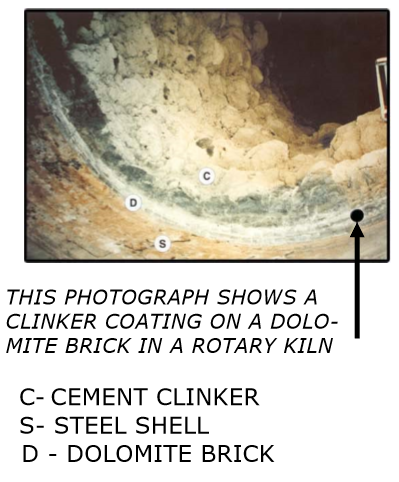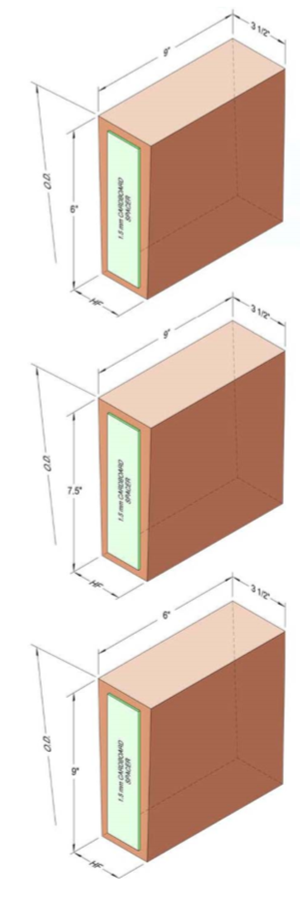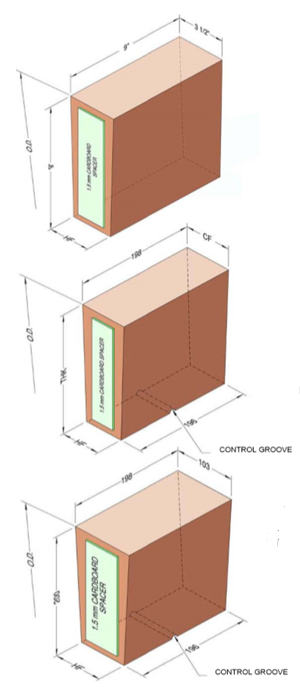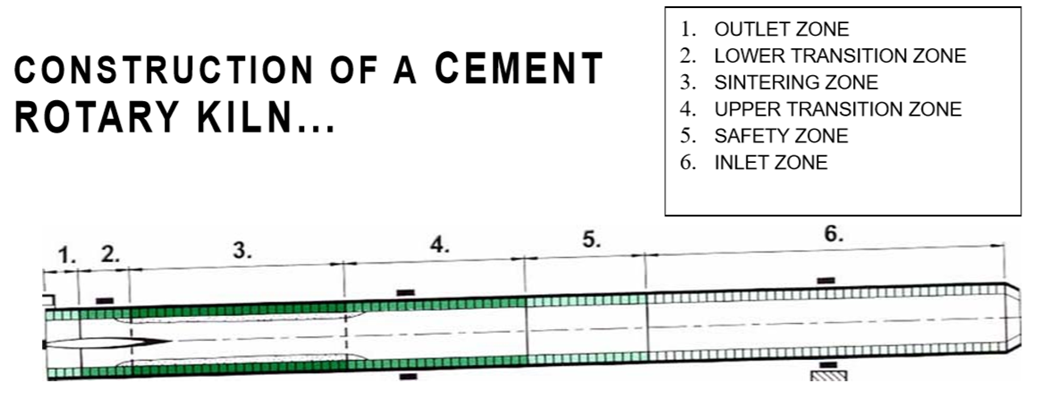Benefits of Dolomite Refractory
Articles
Why Dolomite?

There are a number of unique properties in dolomite brick that make dolomite well suited for use as a refractory lining in a cement rotary kiln. A high degree of refractoriness allows the dolomite brick to withstand the temperatures and stresses involved in the burning zone, the corrosion resistance to alkalis, and a reducing atmosphere, as well as excellent coatability. Finally, the environmental safety of the used materials is outstanding properties of the dolomite brick.
A good coating formation is the most important property of a basic brick. In practice, a coating will form if the conditions in the kiln are appropriate. The biggest difference between different types of brick used in this context is how well they will hold onto the coating once it is formed.
The most important requirement on a refractory lining material used in the burning zone of a cement rotary kiln, the zone of the highest temperatures, is its resistance against chemical reactions. Dolomite bricks do meet these conditions best. The melting phases of the clinker amounting to between 20% and 30% will react with the lime of the refractory brick material at a temperature of about 1450° C forming the minerals alite and belite which are both characterized by very high melting temperatures (2000° C and 2130° C ). Due to this reaction, a solid and stable coating is formed on the surface of the dolomite bricks. The wear of the brick surface will be reduced by the formation of the coating. Further, the coating forms a protection against temperature losses of the clinker burden in the kiln, i.e. reduced heat losses through the shell.
Dolomite Refractory Sizes
9x6 ARCH FORMAT:
 THE 9 X 6 X 3.5” ARCH FORMAT IS THE STANDARD AMERICAN SINGLE SHAPE SYSTEM WHERE A 6” WORKING LINING IS DESIRED. THE COLD FACE HAS A CONSTANT DIMENSION OF 3.5”, WHILE THE HOT FACE DIMENSION VARIES TO FIT THE DESIRED KILN DIAMETER. THE RUNNING LENGTH PER RING IS 9” AND REQUIRES 1.333 RINGS PER FOOT. WRI OFFERS 9 X 6 X 3.5” ARCHES CUSTOM MADE FOR ALL KILNS RANGING FROM 8’-0” TO 18’-0” IN DIAMETER.
THE 9 X 6 X 3.5” ARCH FORMAT IS THE STANDARD AMERICAN SINGLE SHAPE SYSTEM WHERE A 6” WORKING LINING IS DESIRED. THE COLD FACE HAS A CONSTANT DIMENSION OF 3.5”, WHILE THE HOT FACE DIMENSION VARIES TO FIT THE DESIRED KILN DIAMETER. THE RUNNING LENGTH PER RING IS 9” AND REQUIRES 1.333 RINGS PER FOOT. WRI OFFERS 9 X 6 X 3.5” ARCHES CUSTOM MADE FOR ALL KILNS RANGING FROM 8’-0” TO 18’-0” IN DIAMETER.
9x7.5 ARCH FORMAT:
THE 9 x 7.5 x 3.5” ARCH FORMAT IS THE STANDARD AMERICAN SINGLE SHAPE SYSTEM WHERE A 7.5” WORKING LINING IS DESIRED. THE COLD FACE HAS A CONSTANT DIMENSION OF 3.5”, WHILE THE HOT FACE DIMENSION VARIES TO FIT THE DESIRED KILN DIAMETER. THE RUNNING LENGTH PER RING IS 9" AND REQUIRES 1.333 RINGS PER FOOT. WRI OFFERS 9 X 7.5 X 3.5” ARCHES CUSTOM MADE FOR ALL KILNS RANGING FROM 8’-0” TO 18’-0” IN DIAMETER.
9x6 WEDGE FORMAT:
THE 9 X 6 X 3.5” WEDGE FORMAT IS THE STANDARD AMERICAN SINGLE SHAPE SYSTEM WHERE A 9” WORKING LINING IS DESIRED. THE COLD FACE HAS A CONSTANT DIMENSION OF 3.5”, WHILE THE HOT FACE DIMENSION VARIES TO FIT THE DESIRED KILN DIAMETER. THE RUNNING LENGTH PER RING IS 6” AND REQUIRES 2 RINGS PER FOOT. WRI OFFERS 9 X 6 X 3.5” WEDGES CUSTOM MADE FOR ALL KILNS RANGING FROM 8’-0” TO 18’-0” IN DIAMETER.

9x9 WEDGE FORMAT:
THE 9 X 9 WEDGE FORMAT WAS DESIGNED FOR LARGER KILNS WHICH REQUIRE FEWER RINGS PER FOOT. THE COLD FACE HAS A CONSTANT DIMENSION OF 3.5”, WHILE THE HOT FACE VARIES TO THE DESIRED KILN DIAMETER. THE RUNNING LENGTH PER RING IS 9" AND REQUIRES 1.333 RINGS PER FOOT. WRI OFFERS 9 X 9 X3.5" WEDGES FOR ALL KILNS RANGING FROM 18’-0" TO 23’0" IN DIAMETER.
VDZ FORMAT:
THE VDZ FORMAT IS AN INTERNATIONAL TWO SHAPE SERIES WITH THE CENTER OF GRAVITY CHORD FIXED AT 71.5MM (2.81"). THE COLD AND HOT FACE DIMENSIONS VARY WITH EACH SPECIFIED SIZE TO ACCOMMODATE THE VARIOUS KILN DIAMETERS. THE RUNNING LENGTH PER RING IS 198MM (7.60") AND REQUIRES 1.539 RINGS PER FOOT. WRI OFFERS VDZ BRICK IN 180MM, 200MM, 220MM, AND 250MM (7.09”, 7.87”, 8.66”, & 9.84”) LINING THICKNESS.
ISO FORMAT:
THE ISO FORMAT IS AN INTERNATIONAL TWO SHAPE SERIES. THE COLD FACE HAS A CONSTANT DIMENSION OF 103MM (4.06”) WHILE THE HOT FACE DIMENSION VARIES TO THE DESIRED KILN DIAMETER. THE RUNNING LENGTH PER RING IS 198MM (7.80") AND REQUIRES 1.539 RINGS PER FOOT. WRI OFFERS THE ISO BRICK IN 200MM AND 220MM (7.87” & 8.66”) LINING THICKNESS.

The main attack phenomena resulting from burning waste in cement kilns are; increased refractory wear due to corrosion by liquid clinker phases, thermal shock, abrasion, and salt infiltration causing chemical corrosion. The effect of increased levels of alkali, SO3, and chlorine on basic bricks is their structural densification on the hot face as a result of the infiltration of liquid phases. This structural change will make bricks more susceptible to damage by thermocycling.
In order to improve refractory life, it is often necessary to use a combination of basic brick types. The refractory market offers a number of chrome-free brick grades that can be used to cope with varying kiln conditions. As far as development and research in basic bricks is concerned, new means had to be considered to achieve chemical stability, both against corroding liquid phases from the clinker components, as well as from components contained in the kiln atmosphere in a vaporized stage which are able to condense within the brick lining. Therefore, research and development have focused on dolomite-based bricks with low permeability.
The targeted performance life improvement by a MgO-enrichment and reduction of permeability to a minimum would increase brick density, which would be diametrical to the required high thermal shock resistance. Therefore, the thermal elasticity of such brick had simultaneously to be improved to avoid spalling and cracking, which would be caused by thermal variation

